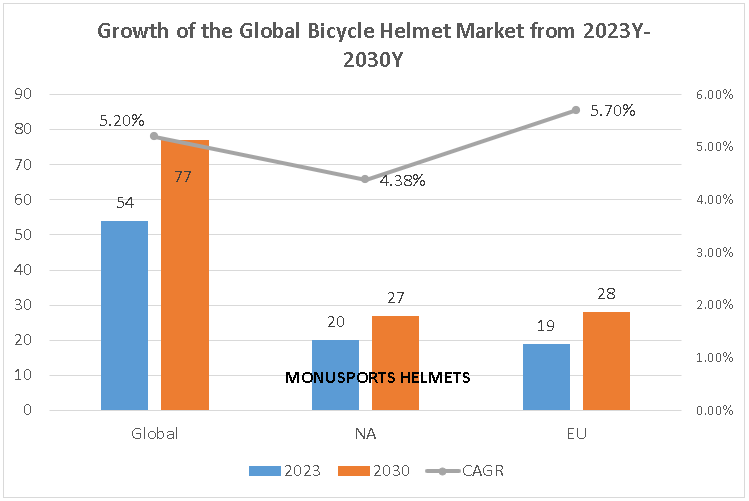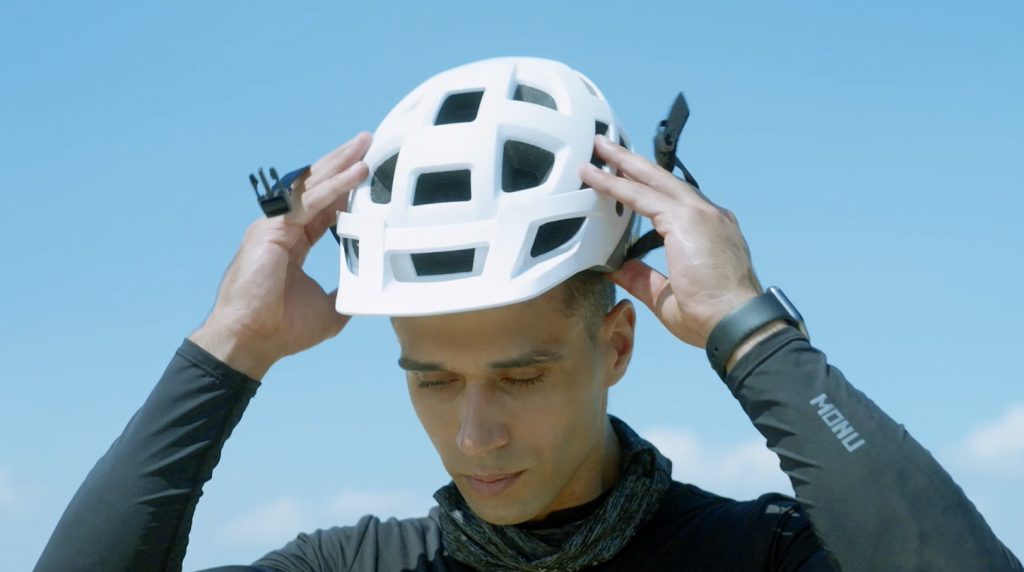Global Bicycle Helmet Market Size Expected to Hit 5.4B Yuan In 2023
Global Bicycle Helmet Market Size and Future Forecast Analysis
According to research statistics from DI Research, the global bicycle helmet market is witnessing steady expansion. The sales revenue of the global bicycle helmet market is projected to reach 5.4 billion yuan in 2023, with an estimated growth to 7.7 billion yuan by 2030, representing a compound annual growth rate (CAGR) of 5.20% from 2023 to 2030. From a regional perspective, North America is the largest consumer market for bicycle helmets. The sales revenue of the North American bicycle helmet market is expected to reach 2 billion yuan in 2023, projected to grow to 2.7 billion yuan by 2030, with a CAGR of 4.38% from 2023 to 2030. Europe follows as the second-largest market, with sales revenue of 1.9 billion yuan in 2023, estimated to reach 2.8 billion yuan by 2030, at a CAGR of 5.70% from 2023 to 2030.

A bicycle helmet is a personal safety equipment typically consisting of a sturdy outer shell and internal cushioning material worn on the head of a cyclist to protect them from potential impact and collision injuries. Bicycle helmets are designed to mitigate the risk of head injuries in accidents such as falls or collisions, providing an additional layer of safety to enable cyclists to enjoy riding their bicycles more safely.
According to research statistics from DI Research, different types of bicycle riding activities may require specific helmet characteristics to meet the riders’ needs. Here are some common subtypes of bicycle helmets:
1. Commuter Helmets:
Commuter helmets are typically ideal for urban or commuting riding. They are lightweight, well-ventilated, and designed with simplicity, suitable for riding in urban environments. They usually have smaller outer shells to provide basic head protection.
2. MTB Helmets:
As mentioned earlier, MTB helmets are designed for mountain biking, emphasizing higher levels of impact protection, additional coverage, and better ventilation. They are suitable for technical and rugged mountain biking, where the risk of falls and collisions is higher.

3. Leisure Helmets:
Leisure helmets are commonly used for recreational riding, such as city strolls, park rides, or casual cycling activities. They are lightweight, comfortable, and typically offer lower levels of head protection, suitable for low-risk environments.
4. Performance Helmets:
Performance helmets are specifically designed for competitive cycling activities, such as road cycling races or mountain biking competitions. They usually feature lightweight designs, excellent ventilation, and superior aerodynamic characteristics to provide optimal performance.
5. BMX Helmets:
BMX helmets are suitable for BMX biking and ramp riding, typically featuring a robust outer shell and additional protection to withstand high-impact risks associated with jumps and technical riding.
Factors Driving the Bicycle Helmet Market
The growth of the bicycle helmet market is influenced by multiple driving factors, including safety awareness, regulations, health, sports activities, technological innovations, and promotion. These trends will continue to drive market growth and encourage manufacturers to offer more innovative and high-performance helmet products. Here is an in-depth analysis of these driving factors:
1. Safety Awareness:
Increased personal safety awareness is a major driving factor for the bicycle helmet market. People are becoming more aware of the risks of traffic accidents and head injuries while cycling, leading to a greater willingness to purchase and use helmets to mitigate potential harm.
2. Regulatory Requirements:
Some regions and countries have implemented regulations mandating helmet use while cycling. These regulations drive the demand for helmets as non-compliance may result in fines or legal liability.
3. Sports and Recreational Activities:
Cycling as a sport and recreational activity is continuously growing worldwide. The increasing number of cycling enthusiasts, professional riders, and cycling clubs contributes to the demand for bicycle helmets as an essential part of their safety equipment.
4. Health Consciousness:
The rising awareness of health and well-being encourages people to choose cycling as a healthy mode of transportation. This trend motivates individuals to invest more in cycling safety gear, including helmets, to protect their heads from potential injuries.
5. Technological Innovations:
Helmet manufacturers are constantly engaged in technological innovations, including lightweight designs, ventilation systems, improved materials, and enhanced comfort. These innovations enhance the appeal of helmets, making them more attractive to consumers.
6. Promotion and Awareness:
Bicycle helmet manufacturers and retailers promote cycling safety awareness through advertisements, awareness campaigns, and social media, encouraging people to wear helmets. Such promotional activities can generate interest among potential buyers, thus driving market demand.
7. Population Growth:
Population growth and urbanization trends mean more people are choosing bicycles as a commuting option, increasing the demand for helmets, especially in congested urban traffic.
8. Online Sales and Convenience:
The proliferation of online sales platforms has made purchasing bicycle helmets more convenient. People can easily buy helmets online and choose products that suit their needs and styles.
Research on Future Technological Trends in Bicycle Helmet Market
The future development of bicycle helmets will combine material innovation, design improvements, integration of smart technologies, and considerations for sustainability to provide higher levels of safety, comfort, and functionality. These trends will meet the growing demand from cyclists for safer, more convenient, and enjoyable riding experiences.
1. Material Innovation:
Future bicycle helmets will be lighter, stronger, and more durable. Advances in new composite materials, carbon fiber, polymer materials, and energy-absorbing materials will improve the helmets’ impact resistance while reducing weight, providing a higher level of protection.
2. Design and Aerodynamics:
Helmet design will focus more on aerodynamics to reduce drag and enhance riding comfort. Scientists and engineers will draw inspiration from wind tunnel testing and biomimicry principles to design more streamlined helmets, making cycling more efficient.
3. Smart Helmets:
Future helmets may integrate smart technologies such as Bluetooth communication, GPS navigation, LED lighting, accident detection, and emergency notification systems. This will enhance the convenience and safety of cycling, allowing riders to connect with other devices and applications.
4. Adjustability:
Helmet adjustability will be improved to better accommodate different head sizes and shapes. The use of more precise adjustment systems, such as adjustable liners and systems with knobs or buttons, will provide a more personalized fit.
5. Ventilation and Cooling:
Ventilation systems will continue to improve to provide better airflow and reduce overheating of the head. This is crucial for the comfort of riders in hot weather conditions.
6. Sustainability and Environmental Friendliness:
Sustainability in helmet manufacturing will become a focal point. The use of recyclable materials, reducing the carbon footprint of production and transportation, and adopting environmentally friendly manufacturing processes will help reduce environmental impact.
7. Virtual Reality and Augmented Reality:
Future helmets may integrate virtual reality (VR) and augmented reality (AR) technologies to provide a more immersive riding experience. This could include displaying navigation information, real-time feedback, and virtual training capabilities.
8. Smart Materials and Biometric Monitoring:
Intelligent materials on helmets can monitor biometric indicators such as brainwave activity, heart rate, and body temperature to provide comprehensive health and safety monitoring. This is particularly useful for emergency response and health tracking in the event of an accident.
Analysis of Limiting Factors in the Bicycle Helmet Market
Helmet manufacturers and relevant stakeholders can take measures including pricing strategies, improved design and comfort, enhanced regulation enforcement, education and promotion, and improved production efficiency to lower costs. Additionally, technological innovations and continuous improvement of helmet performance and style can attract more cyclists to wear helmets. These factors can be further analyzed as follows:
1. Price Pressure:
High-quality bicycle helmets are often relatively expensive, which may limit the purchasing willingness of some consumers. Price sensitivity can lead to market segmentation, making it difficult for less affluent areas or economically disadvantaged consumers to obtain proper head protection.

2. Discomfort:
Some individuals find wearing helmets uncomfortable, especially in high temperatures, which can cause overheating and a lack of breathability. This discomfort can affect people’s determination to wear helmets, especially for long-distance riders.
3. Risk Perception:
In certain areas, the helmet-wearing rate for cyclists is relatively low, partially due to a lower perception of risk while cycling. This can lead to an underestimation of the potential risks of head injuries, resulting in reduced demand for helmets.
4. Fashion Factors:
Some cyclists may choose not to wear helmets because they perceive them as unfashionable, particularly for short rides or social occasions. Improvements in helmet design and more stylish options can alleviate this limiting factor.
5. Regulations and Enforcement:
Helmet-wearing regulations for cyclists vary by region, and some places may not have laws mandating helmet use. The lack of regulations and enforcement can lower the prevalence of helmets.
6. Production Costs and Supply Chain Issues:
Helmet manufacturers face challenges such as fluctuating raw material prices, rising production costs, and supply chain instability. This can result in price increases or supply issues that negatively impact the market.
7. Education and Awareness:
Some individuals may lack sufficient knowledge about the importance of helmets for cycling safety, indicating a need for education and awareness campaigns. Such initiatives can help improve people’s understanding of helmets.
8. Alternative Technologies:
Emerging technologies such as airbag-style helmets or head protection systems may become alternatives to traditional bicycle helmets, offering lower discomfort and higher fashion appeal. This could create competitive pressure on traditional helmets.
Global Bicycle Helmet Manufacturers
According to DI Research, the major global bicycle helmet manufacturers include Vista Outdoor, Giant, Dorel, Trek Bicycle, Mavic, KASK, Merida, Specialized, Uvex, Scott Sports, OGK KABUTO, MET, ABUS, POC, Urge, Lazer, Louis Garneau, LAS helmets, Strategic Sports, Fox Racing, Orbea, Limar, Rudy Project, Moon Helmet, GUB, One Industries, Hardnut Z, Smith, and Monusports.